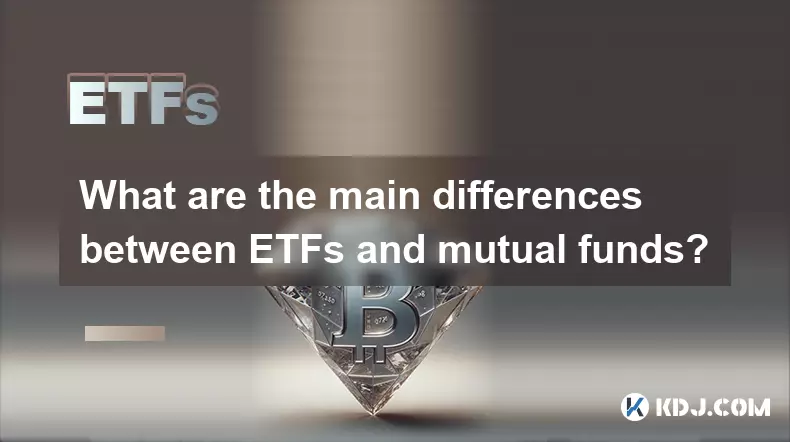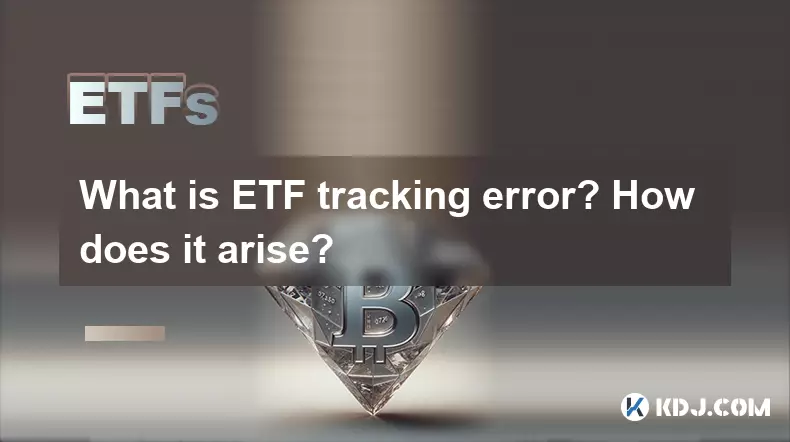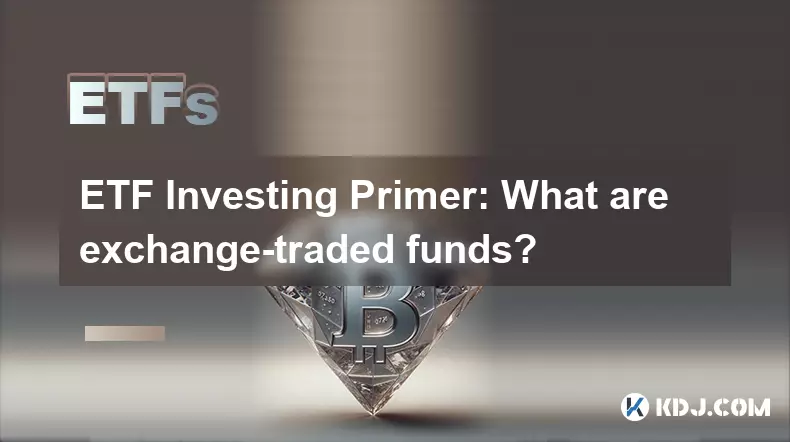-
 bitcoin
bitcoin $109523.663807 USD
-0.13% -
 ethereum
ethereum $4019.526508 USD
2.06% -
 tether
tether $1.000482 USD
0.00% -
 xrp
xrp $2.776815 USD
0.18% -
 bnb
bnb $958.942396 USD
0.12% -
 solana
solana $204.294698 USD
3.84% -
 usd-coin
usd-coin $0.999693 USD
0.00% -
 dogecoin
dogecoin $0.232115 USD
2.09% -
 tron
tron $0.338028 USD
0.84% -
 cardano
cardano $0.790920 USD
1.50% -
 hyperliquid
hyperliquid $44.871443 USD
5.60% -
 ethena-usde
ethena-usde $1.000322 USD
0.04% -
 chainlink
chainlink $21.034165 USD
2.60% -
 avalanche
avalanche $28.794831 USD
-0.54% -
 stellar
stellar $0.360466 USD
1.24%
What are the main differences between ETFs and mutual funds?
ETFs offer intraday trading, lower costs, and tax efficiency vs. mutual funds, which settle once daily at NAV and often carry higher fees and minimum investments.
Sep 21, 2025 at 06:01 pm

Differences in Structure and Trading Mechanism
1. Exchange-traded funds (ETFs) are traded on stock exchanges just like individual stocks, allowing investors to buy and sell shares throughout the trading day at market prices. This real-time trading feature provides flexibility and immediate execution based on current market conditions.
2. Mutual funds, on the other hand, are not traded on exchanges. Their transactions occur once per day after the market closes, with all buy and sell orders executed at the net asset value (NAV) calculated at that time. This means investors cannot react instantly to intraday market movements.
3. ETFs typically have lower expense ratios compared to mutual funds due to their passive management structure and operational efficiency. Many ETFs track specific indexes, reducing the need for active portfolio management.
4. The creation and redemption process for ETFs involves authorized participants who exchange baskets of securities for ETF shares, helping keep the market price close to the NAV. This mechanism is unique to ETFs and contributes to their tax efficiency and liquidity.
Tax Efficiency and Cost Considerations
1. ETFs generally offer superior tax efficiency over mutual funds because of the in-kind redemption process, which minimizes capital gains distributions to shareholders. When investors redeem mutual fund shares, the fund may be forced to sell underlying assets, triggering taxable events for all remaining investors.
2. Mutual funds often come with higher operating expenses, including management fees, 12b-1 fees, and sometimes front-end or back-end sales loads. These costs can significantly reduce overall returns, especially over long investment horizons.
3. Most ETFs do not charge sales loads, making them more accessible to retail investors. Commission-free trading options are widely available through major brokers, further lowering barriers to entry.
4. Due to their transparent structure and lower turnover rates, ETFs tend to generate fewer capital gains than actively managed mutual funds, preserving more value for investors within taxable accounts.
Investor Accessibility and Minimum Requirements
1. ETFs allow investors to purchase as little as one share, making them highly accessible even with limited capital. This granularity supports dollar-cost averaging strategies without requiring large initial investments.
2. Many mutual funds impose minimum investment requirements, sometimes ranging from $500 to tens of thousands of dollars, particularly for institutional or premium share classes. These thresholds can exclude smaller investors.
3. Automatic investment plans are available for both ETFs and mutual funds, but mutual funds traditionally have better integration with such programs directly through fund providers.
4. The absence of mandatory minimums in ETFs empowers traders and long-term investors alike to allocate precisely according to their strategy, enhancing customization and control.
Frequently Asked Questions
Can I invest in cryptocurrency through ETFs?Yes, several regulated cryptocurrency-backed ETFs now exist, primarily focused on Bitcoin and Ethereum futures or spot holdings. These provide exposure to digital assets without requiring direct ownership or custody of coins.
Do mutual funds include cryptocurrency assets?Some mutual funds have begun incorporating crypto-related investments, such as blockchain company equities or indirect exposure via derivatives. However, direct holdings of cryptocurrencies remain rare due to regulatory and custody challenges.
Are ETFs safer than mutual funds?Safety depends on the underlying assets and risk profile rather than structure. Both vehicles can carry high or low risk depending on their investment focus. ETFs tracking volatile sectors like meme coins or leveraged products can be extremely risky.
How do expense ratios impact long-term returns?Even small differences in annual fees compound over time. A fund with a 0.2% expense ratio will leave more money working for the investor compared to one charging 1.5%, especially when compounded across decades of growth.
Disclaimer:info@kdj.com
The information provided is not trading advice. kdj.com does not assume any responsibility for any investments made based on the information provided in this article. Cryptocurrencies are highly volatile and it is highly recommended that you invest with caution after thorough research!
If you believe that the content used on this website infringes your copyright, please contact us immediately (info@kdj.com) and we will delete it promptly.
- Token Costs, AI Scaling, and Computing Power: The Quest for Efficiency
- 2025-09-27 14:25:15
- Qwen3Guard: A Leap Towards Multilingual AI Safety
- 2025-09-27 14:25:15
- Rare 1p Coin Could Fetch £200,000: Are You Holding a Fortune?
- 2025-09-27 12:25:13
- MAGACOIN Finance: Buzz, Risks, and the Altcoin Stampede
- 2025-09-27 12:25:13
- Crypto Wallets & Utility Tokens: What's the Hype?
- 2025-09-27 12:30:02
- Coin Memes, Pumpfun, and ChatGPT: Navigating the Wild West of Crypto
- 2025-09-27 14:30:01
Related knowledge

How do I evaluate an ETF?
Sep 22,2025 at 11:18am
Evaluating the Fundamentals of an ETF1. Examine the underlying index the ETF tracks to understand its investment focus. Whether it follows a broad mar...

What is ETF tracking error? How does it arise?
Sep 20,2025 at 03:18am
Understanding ETF Tracking Error in the Cryptocurrency Market1. Exchange-traded funds (ETFs) have become a significant bridge between traditional fina...

What factors determine ETF liquidity?
Sep 26,2025 at 05:00pm
Understanding ETF Liquidity Drivers1. The underlying assets of an ETF play a crucial role in determining its liquidity. When the securities within the...

How do I understand the creation and redemption mechanisms of an ETF?
Sep 20,2025 at 10:37am
Understanding the Structure of ETFs in the Cryptocurrency Market1. Exchange-traded funds (ETFs) have become a significant bridge between traditional f...

What are the main differences between ETFs and mutual funds?
Sep 21,2025 at 06:01pm
Differences in Structure and Trading Mechanism1. Exchange-traded funds (ETFs) are traded on stock exchanges just like individual stocks, allowing inve...

ETF Investing Primer: What are exchange-traded funds?
Sep 21,2025 at 01:00pm
Understanding Exchange-Traded Funds in the Cryptocurrency Space1. Exchange-traded funds (ETFs) have become a bridge between traditional financial inst...

How do I evaluate an ETF?
Sep 22,2025 at 11:18am
Evaluating the Fundamentals of an ETF1. Examine the underlying index the ETF tracks to understand its investment focus. Whether it follows a broad mar...

What is ETF tracking error? How does it arise?
Sep 20,2025 at 03:18am
Understanding ETF Tracking Error in the Cryptocurrency Market1. Exchange-traded funds (ETFs) have become a significant bridge between traditional fina...

What factors determine ETF liquidity?
Sep 26,2025 at 05:00pm
Understanding ETF Liquidity Drivers1. The underlying assets of an ETF play a crucial role in determining its liquidity. When the securities within the...

How do I understand the creation and redemption mechanisms of an ETF?
Sep 20,2025 at 10:37am
Understanding the Structure of ETFs in the Cryptocurrency Market1. Exchange-traded funds (ETFs) have become a significant bridge between traditional f...

What are the main differences between ETFs and mutual funds?
Sep 21,2025 at 06:01pm
Differences in Structure and Trading Mechanism1. Exchange-traded funds (ETFs) are traded on stock exchanges just like individual stocks, allowing inve...

ETF Investing Primer: What are exchange-traded funds?
Sep 21,2025 at 01:00pm
Understanding Exchange-Traded Funds in the Cryptocurrency Space1. Exchange-traded funds (ETFs) have become a bridge between traditional financial inst...
See all articles










































































